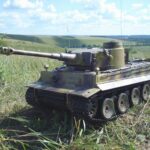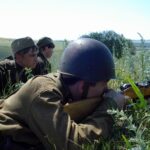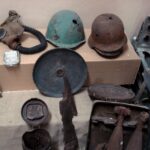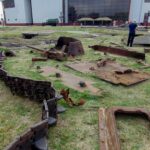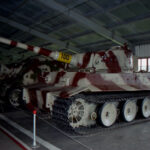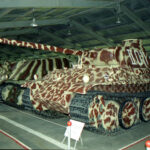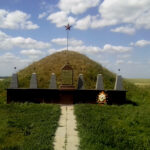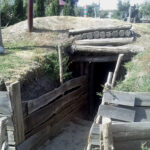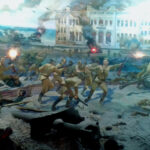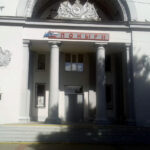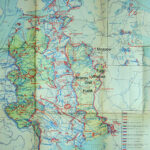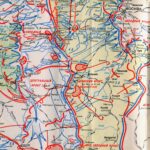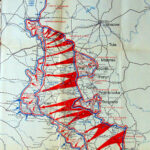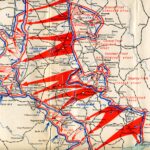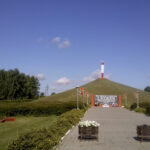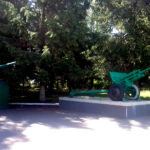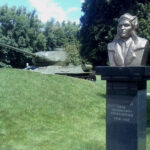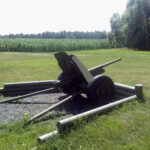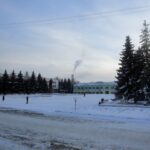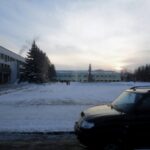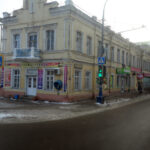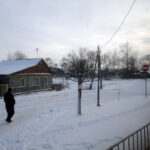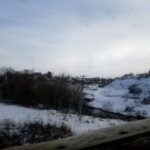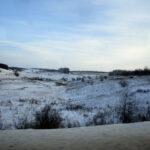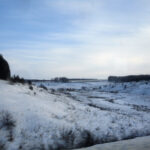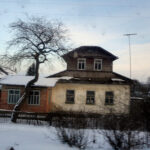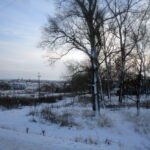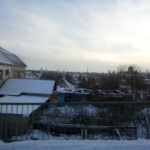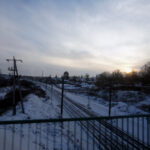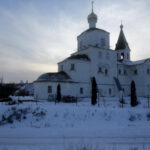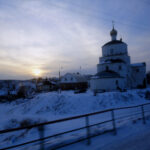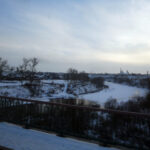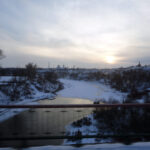The author’s Guide and Reference book of the Kursk-Orel-Prokhorovka battle, made specifically for historians, militaria collectors, military artists, museum employees, WW2 reenactors, and makers of scale models and dioramas.
- German Tiger scale model on the real WW2 battlefields of Kursk in 1943
- ww2 reenactment on the real Eastern front battlefields
- Items found on WW2 battlefields in a local museum
- Remains of soviet tanks found at the battlefields
In connection with the events in Ukraine, it is now dangerous and almost impossible for foreign citizens to visit the battlefields on the Eastern Front. We really hope that in the coming years the situation will change and improve. In the meantime, we write this article so that it can help offset this loss of access. Describing the WW2 battles at Kursk also helps to understand the history and evolution of Soviet and German armored vehicles located in the Saumur tank museum in the Loire Valley, and at the former Kubinka Tank Museum (now taken over by Patriot Park). In the 1943 Battle of Kursk, both sides discovered the shortcomings of German armored vehicles, which helped prompt a rapid evolution of armored vehicle designs and tactics on the Eastern Front. Both sides captured many trophies for evaluation and re-use, some of which are now in the world’s leading tank museums. During the Battle of Kursk, British-American military equipment supplied to the USSR under Lend-Lease was used. The main tanks of the Red Army in 1943 were the T-60 and T-70 light tanks, as well as T-34 (76 mm gun) medium tanks. Heavy British Churchill tanks supplied under Lend-Lease, as well as hastily made SU-152 self-propelled guns, played a significant role in repelling the German offensive. To overpower them offensively, Germany deployed a new generation of heavy tanks for the attempted breakthrough at Kursk, including the new Pz VI “Tiger”.
- Tiger 1 (Panzerkampfwagen VI Ausf. E), Kubinka tank museum archives 2003
- WW2 German Panther tank (PzKpfw V), Kubinka 2003 museum archives
After the unsuccessful advance of German armored vehicles at Prokhorovka, Hitler ordered the offensive to be stopped and the armored units to be transferred to Sicily to hold back the Western Allies. Few people know, but in the Wehrmacht units during the battles of Stalingrad and Kursk, there were many Eastern volunteers (Hi-Wis, slang term for “Hilfswilliger” or auxiliary volunteer, collaborator) and Cossacks. The Wehrmacht also included captured Soviet T-34 tanks with Hi-Wi crews in the battle for Prokhorovka. After these two famous battles, some of the Cossacks and Hi-Wi units were transferred to Normandy and fought against the Allies at the D-Day landings. Especially for WW2 reenactors, in addition to the description of the armored vehicles, we also give a detailed description of the uniforms of the Red Army and even the Hi-Wi volunteers in Wehrmacht service.
Views of nature and landscapes will also help you better choose places in your countries for WW2 reenactment. We also post our description and the Virtual Tour of the battlefields of Operation Citadel on the Eastern Front, as well as events before 1943. Descriptions of WW2 tours are provided by the main experts of Russia and include reviews by tourists from the USA, Canada, France, Germany and the Netherlands. The 1943 Battle of Kursk is considered an internationally famous battle of World War II, on par with the Allied D-Day landings in Normandy. But few people know that there were three battles of Kursk. During the offensive of the German army on Moscow in the fall of 1941 (Operation Typhoon, on October 2), the Kursk region was captured by the enemy. Partisan detachments worked in the occupied territory, there was Resistance, and there were Gestapo atrocities in turn. These events are well represented in the local historical museum of the city of Kursk. On February 2nd, 1943, in the winter, there was a second battle, which ended with the liberation of the city from the German occupiers. The style of the German army was to attack in the summer, in the best conditions for offense. The Red Army, taking advantage of its adaptation to difficult weather conditions and local knowledge, mainly attacked in the winter. Severe frost and snow (General Winter) were good allies of the Red Army.
In the summer of 1943, the German command prepared a large offensive using new heavy types of armored vehicles so as to regain the initiative. By capturing Kursk, they hoped to encircle a large portion of the Soviet army. This operation was known as Operation Citadel, and took place on a salient in the German lines from the city of Orel in the north, through Kursk, and reaching down to Belgorod in the south. On the northern front, the Germans unsuccessfully used “Ferdinand” tank destroyers for the first time, with the main unit having multiple breakdowns on their first combat deployment. Parts of the Red Army defense scheme included massed aviation and the use of armored trains. Not long ago, a good museum and several memorials were organized at the battlefields of the Northern Front. The terrain on the northern face is mostly flat, with occasional hills and small forests. The railway allowed Soviet armored trains to operate in much the same manner that their predecessors operated in World War I, the Russian Civil War, and the Chinese Civil War.
- Monument to repelling the 1943 Citadel operation on the northern front of the battlefield, KN1
- WW2 dugout and trenches near the local military museum, KN3
- Ponyri railway station in a 1943 battle diorama KN2
- Ponyri railway station in our time, KN4
1943 Battle of Kursk
During Operation Citadel, there was a defensive command and observation post near Kursk, which is now a large museum site. In the city of Kursk itself there is also a museum that tourists can visit during a tour of the battle sites.
On the Southern face, the main German offensive to Kursk came from Belgorod in the direction of Oboyan along the highway. The main German forces reached Yakovlevo and turned right in the direction of Prokhorovka, where the Soviets transferred the 5th Guards Army from the Reserve Front. At the battlefields along the highway, the commander of the 1st Tank Army, General Katukov, showed his talent perfectly, inflicting significant damage on German Tiger heavy tanks in ambushes with obsolete T-34 tanks. In Yakovlevo, with the participation of the commander of the tank forces, Marshal Babajanyan, a veteran of these battles, a wonderful memorial and museum was created in 1972. Only at this memorial were the original infantry and artillery positions from World War II preserved. On the Prokhorovsky field itself, all the trenches and foxholes are reproductions, although they were made correctly. After the death of the curators of the museum in Yakovlevo, Marshal Babajanyan, only museums in the Prokhorovsky Field area received further development.
Cold War era Soviet Army official maps of WW2 Eastern front
These official maps of the famous WW2 battles of the Eastern Front and the Battle of Kursk 1943 and 1941 are from the Atlas of the Soviet Army Commander (MB Collection, the Society of Friends of the Tank Museum in Saumur, Loire Valley). The 1941-1943 maps show the main battlefields in English, which include WW2 memorials and the military-historical museums described below.
- Eastern front 1941 map, battle of Orel, Kursk, Tula, Moscow
- 1941 battle of Kursk – Orel – Moscow map
- Eastern front 1943 general map, Orel-Kursk Map
- WW2 1943 Battle of Kursk map
The Heroic Defense of Kursk in 1941, the German occupation in 1942 and the partisans.
The attack on Moscow in 1941 proceeded much slower than the German Blitzkrieg plan and Operation Citadel. The heroic resistance of Soviet soldiers slowed the advance of German vehicles and armored vehicles until the fall. Russian dirt (!) roads still have a very bad reputation, but in the fall during the rains they became impassable for German columns. German troops captured the Kursk region only on October 2, 1941, which also influenced the Battle of Moscow.
Liberation of Kursk in 1943, the Winter Battle
Operation “Zvezda” (Star) to liberate Kursk by the military units of the 60th Army of the Voronezh Front began on February 2, 1943. On the morning of February 7, the fighting took place on the outskirts of the Kursk city, and the next day in the city center. On February 8 at 12 o’clock in the afternoon on the Square of the Palace of Pioneers, the young pupils of Comrade Lenin, the Red Flag was raised. The southwestern outskirts of the city of Kursk was liberated from the Germans on the night of February 9, 1943. The Red Army under the command of General Chernyakhovsky* captured 6 German tanks, 300 cars, 192 motorcycles, 250 guns and many other trophies.
Battle of Kursk or Orel-Kursk Bulge 1943?
During the Cold War, Soviet literature, newspapers, and history books often referred to this great battle as the “Orel-Kursk Bulge.” The leader of the Soviet state Leonid Brezhnev himself, in his report at the Kremlin Palace of Congresses on the 20th anniversary of the Great Victory, said “The gigantic battle on the Orel-Kursk Bulge…” The name “Kursk Bulge” was often used also, undeservedly forgetting about the city of Orel. This battle for recognition continues today between the cities of Orel, Kursk and Belgorod. In addition to advertising and the fame, these are even larger cash subsidies from the state budget for various projects, the museums, and the celebrations. Orel has now the special status of “City of Military Glory”, so we include it in our guide and virtual WW2 battlefields tour.
Orel, City of Military Glory
During the German Operation Typhoon, the defense of the city of Orel in the fall of 1941 took place at the same time and in the same conditions as Kursk, but with some differences. Using superiority in military equipment and soldiers, the tanks of Guderian’s group rushed towards Moscow and on September 30, 1941, went on the offensive and advanced 200 km in three days. On October 3, tanks of the 4th Panzer Division of the Wehrmacht entered the city of Orel and street fighting began. To eliminate the hole in the defense, the Headquarters of the Supreme High Command airlifted 6,000 Soviet paratroopers and two airborne brigades. One battalion landed on the airfield of the city of Orel, which had already been captured by the Germans. Having no means of fighting tanks other than Molotov cocktails, the paratroopers fought heroically and died. The Tank Guard appeared here for the exploits of the crews of Colonel Katukov’s brigade, which stopped the advance of Guderian’s tanks. The outstanding Soviet military leader and future Marshal of Tank Forces Katukov used terrain folds and ambushes to bring enemy tanks within close range and shoot them. Soviet light tanks T-40 and BT could not withstand the German Panzer-III and Panzer-IV, but the situation was saved by the T-34, which became an unpleasant surprise for Guderian.
- WW2 Memorial to the 1941 victims on the Orel-Tula-Moscow highway, M2b
- Square of WW2 tank heroes on the Orel-Mtsensk-Moscow road, M2c
- Memorial to the 1941 tank ambush on the Orel-Moscow highway, M2a
- 45 mm anti-tank gun in ambush position near the road, M2
The heroic resistance and deaths of Soviet soldiers during the Orel-Bryansk defensive operation delayed the enemy for 17 days, which made it possible to build the defense of Tula and Moscow.
During the German occupation, strong partisan detachments operated in the Orel and Bryansk regions, and in the cities there was a Resistance Movement, called “underground” in Russian.
In 1943, during Operation Citadel, the “Northern Front” of the German offensive was located in the Orel region. Here there was a “presentation” of the new German self-propelled guns “Ferdinand.” Their destruction would lead to them becoming rare trophies of the Red Army. The only surviving self-propelled gun “Ferdinand” in the world from this battle is in the tank museum in Kubinka. Another surviving and modernized self-propelled gun “Elefant” is located in the USA. Several military museums have recently been created on these battlefields, photo galleries and descriptions of which are posted below.
On July 12, 1943, Operation Kutuzov began to liberate Orel from the German occupiers. On August 5, 1943, the city of Orel was liberated from the Germans, and the Red Banner was hoisted on one surviving building on Moskovskaya Street. Soviet tank crews played a huge role during the liberation; a special Park was created in Orel in their honor. Soviet aviation made a great contribution to the defeat of the Germans. I would especially like to mention the French pilots of the Normandy squadron and personally commander Zh.L. Tyulyan. In the Battle of Orel, French pilots destroyed 17 German aircraft, but lost 6 of their comrades. We will write separately about the actions of partisans in two regions in the section “Bryansk, partisans and the rail war.” In this section we post a small photo gallery only for the city of Orel.
Photo Gallery and Winter WW2 Battlefield Tour
To better study the weather and terrain, our team specially visited these places at the same time – in early February (2015). We attach a small photo gallery and our reviews. We started our journey in the center of Orel at the Tankmen’s Square and drove through the streets to the outskirts. Outside the city we went towards Kursk to show typical types of terrain in these two regions. Very cold weather, frost and twilight do not allow you to take good photographs, but they help you better feel the nature of the weather. Please note that there are rivers, ravines, forests, hills and fields. We will also post our travel and the types of terrain in the summer in this section.
- Great Lenin, organizer of all victories of the Soviet people, city of Orel, O1
- Soviet propaganda, monument to Comrade Lenin from the other side, O2
- Soviet Tankmen’s Square, T-34-85 and Orel city center, O3
- Moscow street where the Red Flag was hoisted in the city of Orel, O4
- An ordinary village in Orel and Kursk regions, O6
- Small rivers and positions where there were medieval wooden fortresses, O6
- Gullies and beams for the tanks, the forests for WW2 infantry
- Hills for machine gun nests, difficult to attack, O8
- In the bitter cold, the Germans used houses (nicknamed “hut”) as barracks and headquarters, O9
- Therefore, the NKVD ordered special saboteurs to burn all houses at a distance of 50 km from the road in winter, O10
- Local residents near railway stations are required to collect information about German trains and cargo, O12
- The NKVD ordered the partisans to blow up all railways (“rail war”), O11
- Ancient Orthodox stone churches were used as fortresses, O13
- During WW2 battles, the churches were used also as the observation posts to adjust artillery fire, O14
- Bridges were quickly demolished, but Soviet light tanks like T-40 and T-60 could cross the river on the ice, O15
- Depending on the temperature, the ice could be durably thick or very thin, making crossings a game of chance, O16
Uniforms and Insignia During 1941-1943 Kursk – Orel – Prokhorovka Battles
Red Army. Please note that the uniform of the Red Army in 1941 changed slightly from peacetime to wartime, becoming simpler, khaki in color and with new elements of the uniform. 1943 was a turning point in this process, with new shoulder straps added to a new type of tunic without a collar. The command of the Red Army gave 1 year to change the uniform, as a result, hybrid versions of the old and new types appeared.
Wehrmacht and Waffen SS uniforms, especially tank’s crew and panzergrenadiers, are well described in the Western books, so in this section we will minimize this topic. Use examples only.
ROA, Cossacks and Hi-Wi. In 1943, the official uniform and insignia of the ROA (Russian Liberation Army) appeared, but during battles the old type was used for the Eastern Volunteers, Hi-Wi’s and Cossacks. A new type of uniform for the ROA and Cossacks appeared en masse after the transfer to the Western Front in 1944, to France, Normandy and the entire Atlantic Wall.
to be continued…

